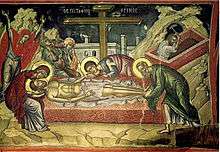Theophanes the Cretan


Theophanis Strelitzas (Greek: Θεοφάνης Στρελίτζας), also known as Theophanes the Cretan (Θεοφάνης ο Κρης, "Theophanis of Crete") or Theophanes Bathas (Θεοφάνης Μπαθάς), was a leading icon painter of the Cretan School in the first half of the sixteenth century, and in particular the most important figure in Greek fresco-painting of the period.
He was born in Heraklion in Crete (date unknown), and no doubt trained there, but all his known work was done in mainland Greece. Frescoes bearing his signature survive in the Greek monasteries of Mt. Athos, especially Stavronikita monastery and Lavra, and in Meteora, which has his earliest dated work, from 1527. He also did many panel icons, either for iconostases or small portable works. Theophanes was active from about 1527-48, and trained his sons and several pupils, often themselves Cretan. By 1535 both he and his two sons had become monks in the Lavra monastery of Mount Athos, where many of his best works remain. Theophanes returned to Crete before his death in 1559.
Two detached wallpaintings attributed to Theophanes are in the Hermitage Museum in Saint Petersburg. Like most Cretan painters of this date, his work shows some influence from Western painting, but less in his case than with many artists. Some faces are personalised or looking out to the viewer, and his figures are modelled to convey volume. His work is more conscious of visual perspective than older Byzantine artists, but he does not use the geometrical perspective schemes by then standard in the West. He uses traditional Byzantine compositions, in a rather austere and powerful manner.
References
 Media related to Theophanes the Cretan at Wikimedia Commons
Media related to Theophanes the Cretan at Wikimedia Commons- Article on his frescoes
- Theophanes of Crete in Byzantine art
External links
- Byzantium: faith and power (1261-1557), an exhibition catalog from The Metropolitan Museum of Art (fully available online as PDF), which contains material on Theophanes the Cretan